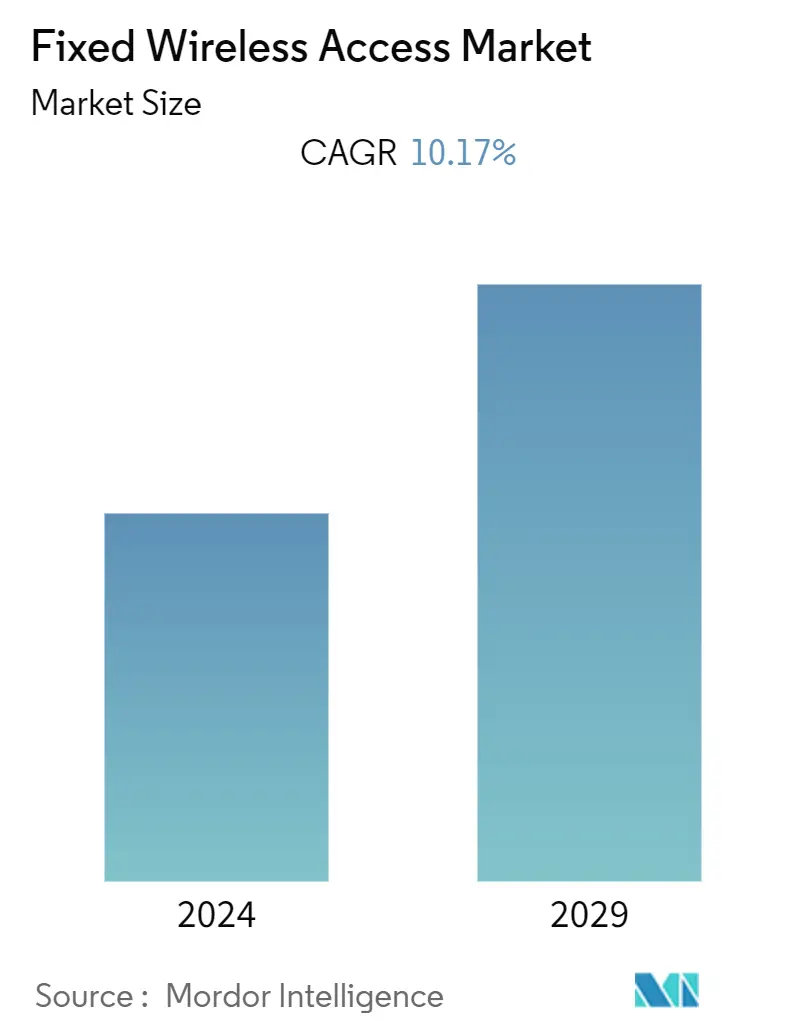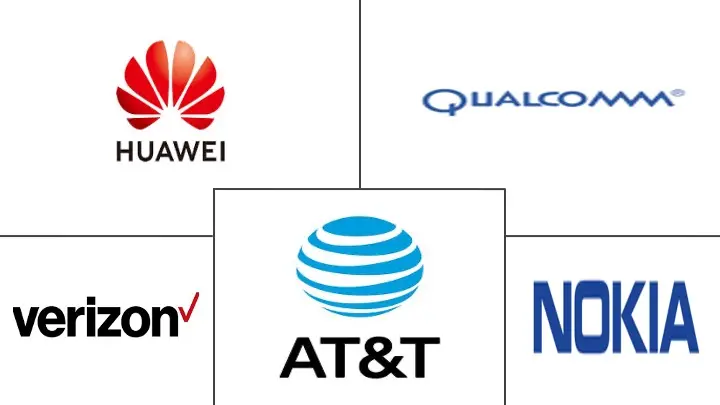Market Size of Fixed Wireless Access Industry

| Study Period | 2019 - 2029 |
| Base Year For Estimation | 2023 |
| CAGR (2024 - 2029) | 10.17 % |
| Fastest Growing Market | Asia Pacific |
| Largest Market | North America |
| Market Concentration | Medium |
Major Players
*Disclaimer: Major Players sorted in no particular order |
Fixed Wireless Access Market Analysis
The Fixed Wireless Access Market is expected to register a CAGR of 10.17% during the forecast period.
- The demand for internet connectivity among households has increased with the growth in connected devices. Additionally, wearable technology has improved in various emerging economies, contributing to the need for better wireless broadband connectivity.
- Additionally, the steady evolution of wireless broadband technology over the past decade keeps pace with advances in standards set by the Institute of Electrical and Electronics Engineers (IEEE). These standards are modernized to improve the network throughput regarding maximum speed and transmission capability. These upgrades have given the companies in the market the means to strive for innovation and successfully satisfy the customers' demand for higher bandwidth and faster internet, driving the market's growth significantly.
- Also, the increasing demand for faster internet connectivity among consumers, owing to the data size becoming more prominent and the rise in the number of devices connected to the device, is spurring the demand for fixed wireless access with effective connectivity. Further, the increase in the number of connected devices and increasing focus and implementation of smart homes using smart devices are expected to fuel the market demand during the forecast period. Moreover, the growing adoption of smart home architecture worldwide, including remote access, voice control, and seamless connectivity, further drives the demand in the market studied.
- Furthermore, with the 5G network launch, the emerging economies in the Asia-Pacific region are expected to propel the market for fixed wireless access during the study period. According to the Ericsson Mobility Report, 5G subscriptions are expected to reach 1 billion by the end of the year. More smart 5G devices with additional capabilities are expected this year. In five years, the 5G subscriptions are anticipated to surpass 5 billion, and Fixed Wireless Access (FWA) connections will reach around 300 million, where 5G will account for about 80 % of FWA connections.
- However, aspects like the rising dependence on Spectrum Allocation in Some Countries and Cost and Environmental Challenges Associated with Millimeter-wave Technology might be some factors that can restrain the market's growth throughout the forecasted period.
- Amid the COVID-19 crisis, fixed wireless access (FWA) solutions would likely witness increased demand and fill in fiber broadband networks. This results from a sudden and widespread explosion in telecommuting by employees worldwide who can work from home. According to Preseem, a quality monitoring and optimization platform for fixed wireless networks, the increased demand is especially significant during business hours.
Fixed Wireless Access Industry Segmentation
Fixed Wireless Access (FWA) is an alternative to internet connectivity that uses wireless network technology rather than fixed lines. An access unit is attached to street furniture, which wirelessly connects to a receiver placed inside a home or business property. The receiver then feeds a router, which provides a WiFi signal into the building, enabling users to connect their numerous everyday devices.
The Fixed Wireless Access Market is segmented by type (hardware, services), application (residential, commercial, industrial), and geography (North America, Europe, Asia-Pacific, Rest of the World).
The market sizes and forecasts are provided in terms of value (USD) for all the above segments.
| By Type | ||||
| ||||
| Services |
| By Application | |
| Residential | |
| Commercial | |
| Industrial |
| Geography | |
| North America | |
| Europe | |
| Asia Pacific | |
| Rest of the World |
Fixed Wireless Access Market Size Summary
The Fixed Wireless Access (FWA) market is poised for significant growth, driven by the increasing demand for high-speed internet connectivity and the proliferation of connected devices. As households and businesses seek faster and more reliable internet solutions, FWA technology, which utilizes wireless mobile networks instead of traditional fixed lines, is becoming an attractive option. This trend is further bolstered by the advancements in wireless broadband technology, aligning with the evolving standards set by the Institute of Electrical and Electronics Engineers (IEEE). The rise of smart homes and the integration of IoT devices are also contributing to the market's expansion, as consumers demand seamless connectivity and enhanced bandwidth. The introduction of 5G networks, particularly in emerging economies, is expected to further accelerate the adoption of FWA solutions, offering competitive speeds and reducing the need for extensive infrastructure investments.
North America is anticipated to dominate the global FWA market, with significant investments in high-speed internet solutions to bridge the connectivity gap in rural and underserved areas. The region's focus on integrating small cells with Wi-Fi to enhance IoT connectivity and data services is a key driver of market growth. Companies are actively launching new 5G offerings and forming strategic partnerships to expand their market presence and improve service delivery. Despite challenges such as spectrum allocation and environmental concerns, the FWA market remains fragmented, with numerous players vying for market share through innovation and strategic collaborations. Recent developments, including trials and deployments of advanced FWA solutions in various regions, underscore the dynamic nature of the market and its potential for lucrative growth opportunities in the coming years.
Fixed Wireless Access Market Size - Table of Contents
-
1. MARKET INSIGHTS
-
1.1 Market Overview
-
1.2 Industry Value Chain Analysis
-
1.3 Industry Attractiveness - Porter's Five Forces Analysis
-
1.3.1 Bargaining Power of Suppliers
-
1.3.2 Bargaining Power of Buyers/Consumers
-
1.3.3 Threat of New Entrants
-
1.3.4 Threat of Substitute Products
-
1.3.5 Intensity of Competitive Rivalry
-
-
1.4 Technology Snapshot
-
1.4.1 Analysis of Key Enablers for the Adoption of FWA
-
1.4.2 Key Initiatives Undertaken by Notable Vendors
-
1.4.3 Key Business Considerations and Pre-requisites
-
1.4.4 Comparative Analysis of FWA With FTTH and FTTdp
-
1.4.5 Analysis of Key Business Models and Use Cases in Rural, Semi-urban, and Urban Areas
-
-
1.5 Assessment of COVID-19 impact on the Fixed Wireless Access Market
-
-
2. MARKET SEGMENTATION
-
2.1 By Type
-
2.1.1 Hardware
-
2.1.1.1 Consumer Premise Equipment (CPE)
-
2.1.1.2 Access units (Femto & Picocells)
-
-
2.1.2 Services
-
-
2.2 By Application
-
2.2.1 Residential
-
2.2.2 Commercial
-
2.2.3 Industrial
-
-
2.3 Geography
-
2.3.1 North America
-
2.3.2 Europe
-
2.3.3 Asia Pacific
-
2.3.4 Rest of the World
-
-
Fixed Wireless Access Market Size FAQs
What is the current Fixed Wireless Access Market size?
The Fixed Wireless Access Market is projected to register a CAGR of 10.17% during the forecast period (2024-2029)
Who are the key players in Fixed Wireless Access Market?
Huawei Technologies Co., Ltd., Nokia Corporation, AT&T, Inc., Verizon Communications, Inc. and Qualcomm Technologies Inc. are the major companies operating in the Fixed Wireless Access Market.

